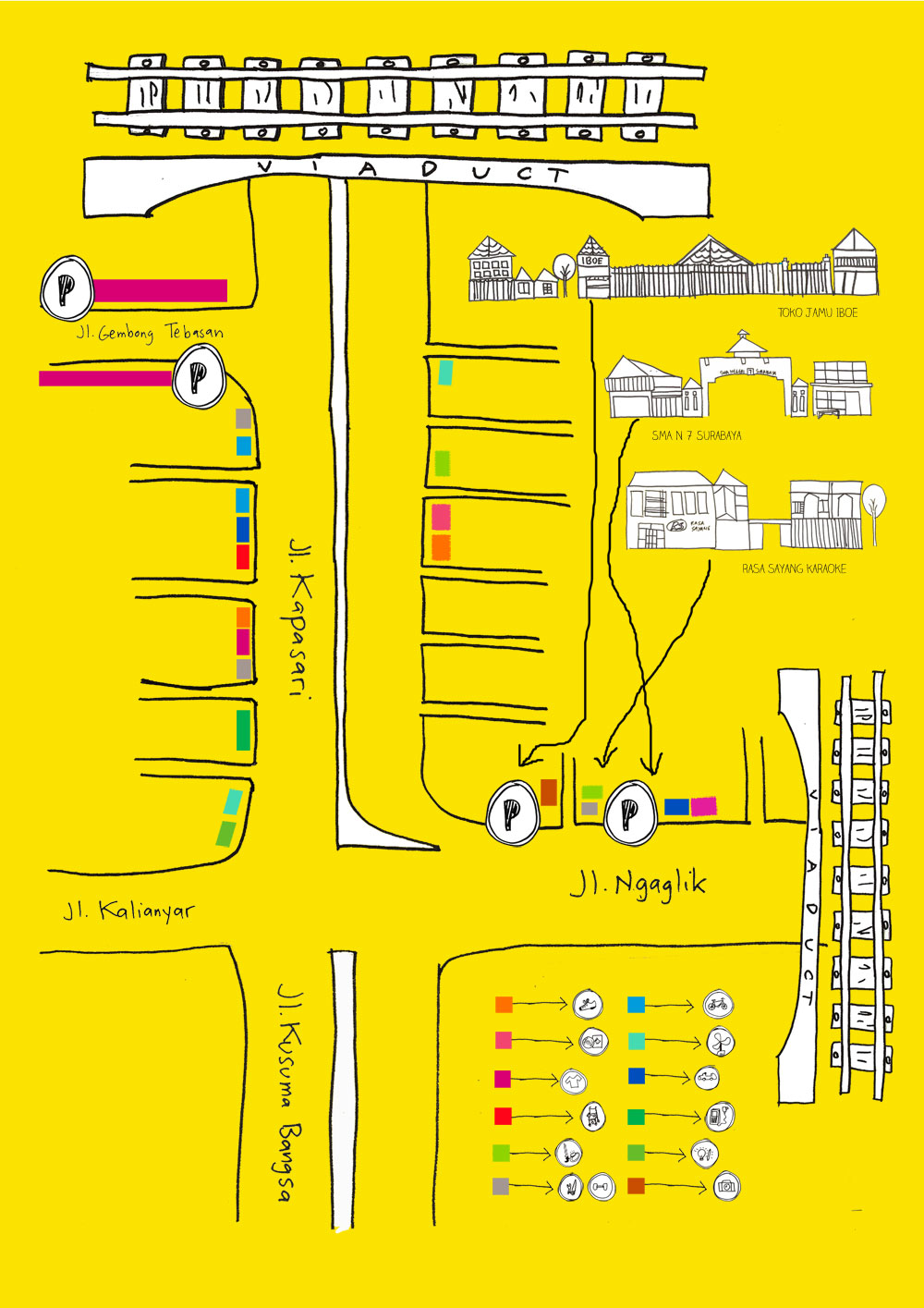
Gembong 1: Kapasari
Let us begin our journey in this thrift heaven from the area most congested by the traders, the Gembong in Kapasari area. If you come from the Hi-Tech Mall or Kusuma Bangsa Street, you will see that the left side of the street is more dense with traders than the right side. The left side is a merchant ‘territory’, which starts from the beginning of Kapasari Road, and continues uninterrupted until just before the railroad. In contrast, the right side of the road is more sparsely populated and is not continuously filled from end to end. Like the majority of traders in other areas, the merchants here do not take holidays—they are open every day.
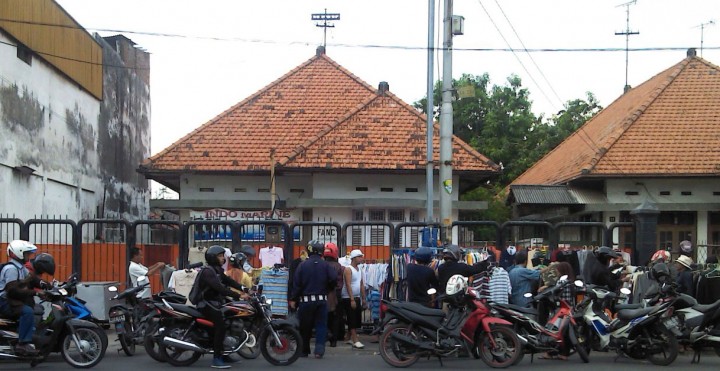
The busy period for the market varies from day to day. On normal days, the market is crowded in the afternoon hours before sunset to take advantage of people coming home from work. It is even more crowded on the weekend afternoons. Meanwhile, in the morning there are only a few sellers selling their wares.
In general, the items for sale in the Kapasari area are similar to what you will find at Ngaglik, because both sell “everything”. The difference in the merchandise is that Kapasari has more uniform types of good than Ngaglik. From day to day, the stalls are always selling the same type of goods. If you see them selling household supplies today, chances are you’ll see them selling the same stuff the next day, and so on.
The merchandise displayed in this area is mixed. Most sellers organize their merchandise, or even leave them in piles on top of a tarp rolled on the side of the street. Sometimes they are lined up on the wall, encroaching any vacant space, which in Javanese is called pating cerentel. Some might have their own shop, but still leave a bit of their wares jutting into the road.
Used clothing wholesalers use hangers to display their merchandise. Some organize them according to the types: jeans, windbreaker jackets, flannel shirts, and so on. Some of the unique items that can be found in the Kapasari area are: old eyeglass frames, parts for electronic fans (caps and blades), carpentry tools similar to what you would find at the supermarket, baby walkers and strollers, bicycles for both adults and children, and fixie or folding bikes in a variety of conditions. There is also a store that sells modified wheelchairs-their seats having been replaced with party plastic chairs. According to its seller, the chairs have been modified by the previous owners so they are easier to use, even for bathing. Apparently, these chairs are often ordered by a number of hospitals for patient needs. In addition, there are also (used) bicycle spare parts, hydraulic pumps, roller skates (from those with detachable wheels to in-line roller blades), sitting next to chains and weights in the same stall. Meanwhile, on the right side of Kapasari Road, we can find leather shoes, fans and home electronics, all of which are old models. You can also find a variety of CDs and cassettes here, from both Indonesia and overseas.
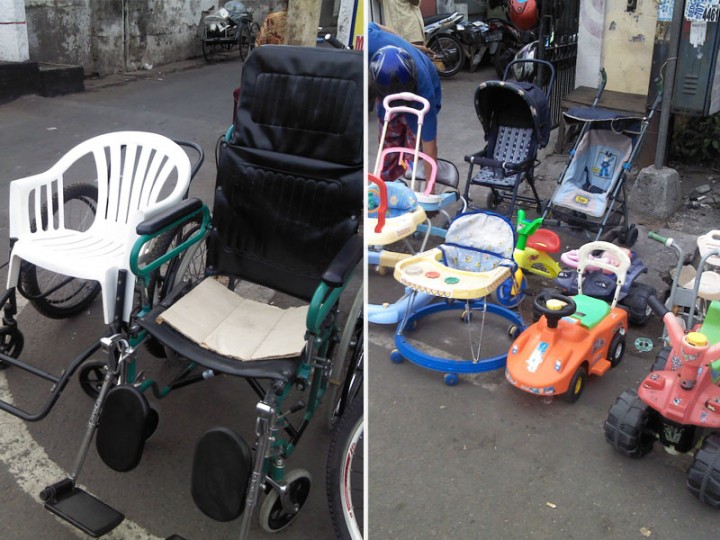
Modified wheelchairs and baby walkers
There is also a store that sells modified wheelchairs-their seats having been replaced with party plastic chairs. According to its seller, the chairs have been modified by the previous owners so they are easier to use, even for bathing. Apparently, these chairs are often ordered by a number of hospitals for patient needs. In addition, there are also (used) bicycle spare parts, hydraulic pumps, roller skates (from those with detachable wheels to in-line roller blades), sitting next to chains and weights in the same stall.
Meanwhile, on the right side of Kapasari Road, we can find leather shoes, fans and home electronics, all of which are old models. You can also find a variety of CDs and cassettes here, from both Indonesia and overseas.
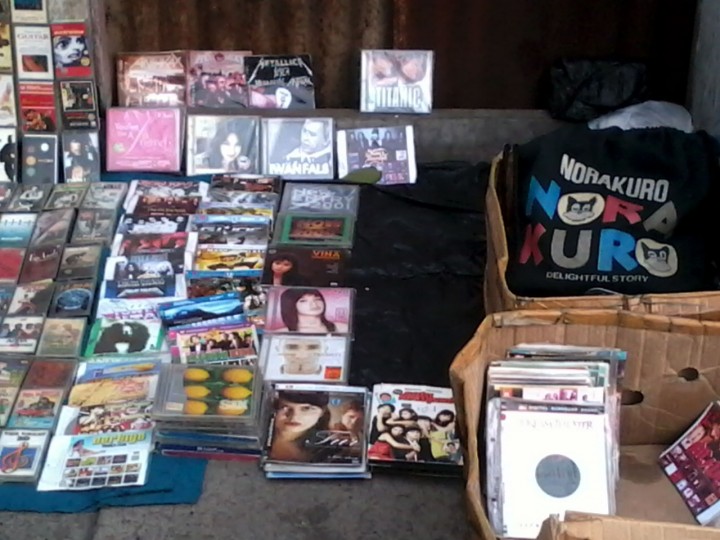
Gembong 2: Gembong Tebasan
This area can be regarded as the fashion center of Gembong Market, since all merchandise traded here is secondhand clothing. Unlike Kapasari and Ngaglik, stalls in Gembong Tebasan usually close at 5pm. If you are a good scavenger, you can find some designer clothes (secondhand, with little damage or stains at all, but armed with creativity of course it would not be such a big deal, right?). For those of you who are new to the workforce, or need a costume for your theatre, it also could be a good place to shop because they have many old and formal styles, which are suitable as costumes for drama that takes place in the past. The temperature in Surabaya is hot, but these sweaters and jackets are hard to resist.
Gembong 3: Ngaglik
The Ngaglik area is as diverse as Kapasari, but it tends to get more and more crowded towards the evening. These areas also tend to be more crowded on the left side of the road (if you come from the direction of Hi-Tech Mall), perhaps because of the one-way street. On the left side of the road there is a bridge that is large enough to be entered by a car, with traders on on either side of the road. While the Kapasari merchants sell consistent and uniform types of merchandise, in Ngaglik there are quite a lot of traders with many different types of merchandise every day. If today the trader is selling frying pans, tomorrow they might be selling radios. Perhaps next week you’ll see the same stall selling comics. The merchandise is not necessarily rotated daily, though, as sometimes it happens weekly, depending on what items they can get. There are many diverse items that you can find here: on a tarpaulin mat you might find analog cameras, tape, test tubes, comics, jars, pipes and even reflexology tools. Some vendors sell their wares on baskets where they may put a pile of jeans in one, and fan spare parts in the other.
When night falls, the number of traders on the main road increases. In addition to the booming amount of visitors that take up half of the main street, the stalls also gear themselves to be more presentable. Items for sale include new and used light bulbs, leather wallets—sometimes complete with the packaging, electronics, internet modems, various accessories, tools and others. “Occult” stuff, like a keris dagger and agate can also be found here. Funnily enough, during daylight these occult items are located next to the children’s toys.
Unique items that can also be found in this area include old vintage radios, small televisions, walkmans, discmans, household electronics parts (for example, blenders without the bowls, only the whisks), Blackberrys (considerably quite expensive smartphones), flash cameras that are no longer intact, and analog cameras at the price of 35 to 60 thousand rupiahs. The sellers say that most people are looking for Canon, Nikon and Yasica. Traders sometimes claim to even be able to get a camera fully equipped with a telephoto lens.
Comparable to the used books center on Semarang street, in Gembong Ngaglik we can also find vendors selling complete comics series. In addition to this comics series, you can also find a number of Holy Bibles, greeting cards and angpao red envelopes–notes half-filled by the original owner.
Meet them in Gembong!
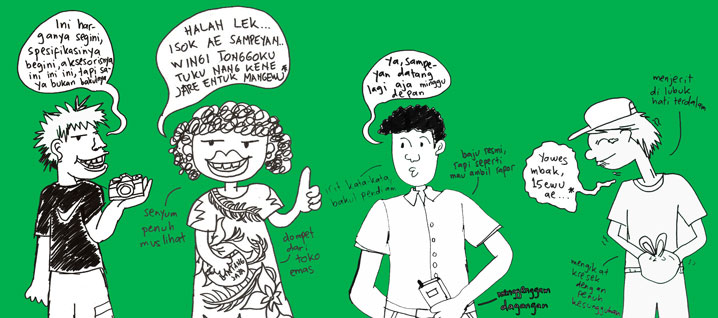
There are many interesting characters that you may often encounter in Gembong market. First, some local female residents in their daster (house dress) will ruthlessly haggle for bargain prices, usually through this line, “loh tonggoku tuku nang kene jarene cumak mangewu!” (Yesterday my neighbor said it only cost five thousand rupiahs!), although the item is priced at five times that.
The second is the omniscient, all-knowing resident who is usually mistaken as a seller. His characteristics: he understands which items are sold at which stall, he looks busy in front of a stall, and if there are any prospective buyers who seem confused or hesitant, he immediately approaches and talks with them, sometimes even giving in-depth explanations. When he finishes his explanation, the prospective buyer may ask, “how much is this, Pak?” upon which he will give a world-weary sigh, as if saying, “here we go again,” and grins, “sorry, I’m not the seller.”
Third, old men looking for antique items (usually keris daggers and agate stones).
Fourth, traders in neat safari clothes (popularized during the New Order).
Fifth, men wearing bamboo hats, dark faded shirts and bermuda pants, and carrying brightly-colored energy drinks in hand.
English version edited by Will Glasscock
This post is also available in: Indonesian



